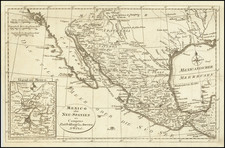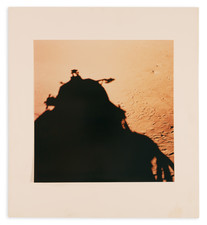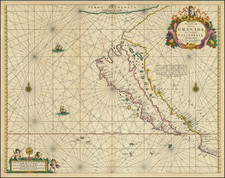Original Photographs of the Short-Lived 1889-90 Baja California Gold Rush
A wonderful group of three very rare photographs of the El Alamo, Baja California Gold Mines during the Baja Gold Rush of 1889.
The photos are as follows:
- Camp Alamo, Lower Calif. in 1889. A bird's-eye view of the mining camp, made up of tents. A mountain looms in the background.
- Gold Avenue, Alamo. Dated on verso of mount: May 1889. A view within the mining camp itself. Tents, a horse-drawn buggy. About 12 miners standing in the view.
- Placer gold mining at Alamo, Lower Calif. 1890. Shows a group of 8 miners wielding shovels.
El Alamo Mining District
The El Alamo mining district, located in northern Baja California, just east of Ensenada, experienced a brief mining boom in the late 1880s.
Except for certain coastal areas, most of the peninsula of Baja California remained undeveloped well into the 19th-century. While some of the early Jesuit missions in the peninsula became incidental sites for early mining, often utilizing labor from the indigenous populations, the exent of mining activities in the region remained limited.
In 1888, significant developments occurred with the discovery of gold placers just north of El Alamo. This discovery led to a substantial mining rush, elevating El Alamo to the status of the largest town in Baja California at the time (with an estimated peak population of 5,000), directly influencing the growth and revitalization of the nearby port town of Ensenada.
The discovery was initially made by Rafael Lopez in October 1888 in the Alamo Basin, surrounded by notable geographic features such as Tomasa, Alamo, Rosario, and Pinon mountains. Following Lopez’s findings, L.H. Gaskill and a party confirmed the existence of rich placer diggings in February 1889, notably in Mexican Gulch. This led to a rapid influx of population, particularly from Ensenada and San Diego.
Significant figure in the subsequent development of the district included Engineer Tyzack, Colonel Allen, A.H. Butler, T.L. McCarthy, and the partnerships of Frey & Waldrip, who were among the many who contributed to the expansion and exploitation of the mining potential of the area. Their efforts led to the establishment of several mines, extensive prospecting activities, and the development of infrastructure to support quartz mining.
A local newspaper reporter from San Diego named Capt. Edward Friend visited El Alamo mining district and published a series of articles in San Diego papers about the gold discovery in Baja California. By 1891 the following account by Friend appeared in a special number of the El Cajon Star:
Seven days were consumed between Ensenada and the camp, for as there were litterally [sic] no roads to travel roads had to be builded [sic]. The party arrived late in the afternoon and early the next morning the writer went to the head of what he named Mexican Gulch. There were possibly three hundred Mexicans and Indians at work within a distance of one hundred yards and gold nuggets were being taken out whenever he stopped to take notes for his paper... The gold was there and I had seen it; virgin in purity and rich in color... I could see myself as I returned to America..."The Conquering Hero Comes,"... made rich with Santa Clara gold...This is the way I dreamed it... When the people came down there three weeks later and wanted to hang me, and ran me all over the mountains, and knocked two of my front teeth out... and everybody said I was worse than a murderer; the dream didn't go.
By 1908, records indicate that the El Alamo-Santa Clara camp had produced approximately 217,000 ounces of gold, making it a significant site in the history of mining in Baja California. The district's development featured not only the economic aspects of mining but also the establishment of community infrastructure, including shops, schools, and media outlets, reflecting the comprehensive impact of the gold rush on the region. The Mexican Revolution and the subsequent decade of political instability effectively shut down the remaining mining activity at El Alamo, with only smattering of placer deposits being worked by locals. The prohibition of foreigners owning land near the border or the coasts effectively shut down all mining activity in Baja California. Thus, like many mining towns El Alamo's vitality and bustle quickly diminished. Today the area is barely inhabited - with one online source giving the population as 1.
For further background on the Baja California Gold Rush of 1889, see Richard Lingenfelter's book: The Rush of '89 : the Baja California Gold fever & Captain James Edward Friend's letters from the Santa Clara mines (Los Angeles: Dawson's Book Shop, 1967).
Rarity
Original photographs depicting El Alamo in 1889 are extremely rare. A quick online search failed to turn up any confirmed images of the El Alamo or Santa Clara Mining District during the 1889 Gold Rush. The present images would seem to be unique visual survivals of a fleeting but notable Gold Rush near Ensenada, the U.S.-Mexico border region.











![(Los Angeles Architecture) [Photograph of a 1920s Spanish Colonial Revival home, likely in the Hollywood Hills area; with glass plate negative]](https://storage.googleapis.com/raremaps/img/small/96755.jpg)




